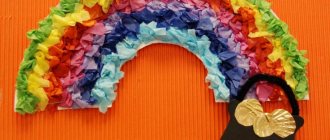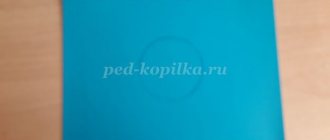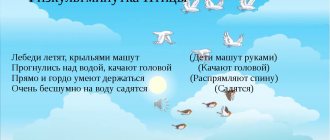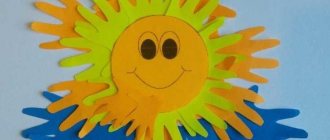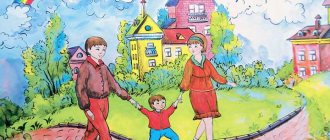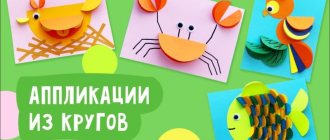Lesson summary on application (HLS)
Topic: “Vitamins are my best friends”
Software tasks:
- Arouse children's interest in a conversation on a certain topic.
— Fix the names of the colors (red, green, yellow)
— Introduce the vitamin properties of vegetables and fruits.
— Continue to cultivate responsiveness, kindness, and empathy in children.
— To develop children’s interest in applique, to strengthen the ability to use a brush when applying glue.
Materials and equipment:
A sheet of paper in A 1 format with an image of a basket, blanks of fruits and vegetables cut out of colored paper, glue pencil, napkins, pictures of polar bears, Doctor Aibolit.
Contents of the lesson
:
Educator
: Far, far in the north, where there is always winter and snow, polar bears live. They got into trouble and got sick. The cubs had a fever and a sore throat, and the mother bears put thermometers on them. Then the cubs remembered about Doctor Aibolit, who treats everyone in the world.
Treats small children
Heals birds and animals
He looks through his glasses,
Good Doctor Aibolit.
Educator
: The bears then sent a telegram to Doctor Aibolit: “Dear Doctor Aibolit, hurry up, come here quickly, we are sick.”
He flew on an eagle, through storms and rain, he stood on a rock, not afraid of anything. He came to the cubs and began to treat them. What do you think Doctor Aibolit used to treat the little bear cubs?
Children
: Tablets, syrup….
Educator
: That's right guys! And the cubs soon recovered. Only they were very weak after the illness...
Educator
: (unexpectedly) Oh guys, look, we have a letter! (shows the letter) Who is it from, you need to read it: “Little bear cubs need fruits and vegetables rich in vitamins. Help me guys. Dr. Aibolit".
Educator
: But where can we get so many fruits and vegetables? What should we do? Guys, do you eat fruits and vegetables?
Children
: Yes.
Educator
: Do you know that fruits and vegetables are very healthy, they are rich in vitamins. But each fruit or vegetable is beneficial in its own way. (Song about vitamins).
Educator
: Well, where can we get so many vegetables and fruits to help the bear cubs? Guys, I know! We can help by collecting a whole basket of vitamins. And before we get to our basket, we'll play a little.
We'll squat down
And in the garden we will plant,
Onions, carrots, dill, peas,
Our harvest is not bad!
Educator
: Well done, well, now, we have warmed up and are ready to collect fruits and vegetables!
(Children approach the tables on which whatman paper with a drawn basket, glue, and napkins are prepared!)
At the end of the lesson, the children, together with the teacher, look at what they did! What a big basket they prepared for the cubs. As a surprise, in the end, the teacher brings out a plate of prepared fresh vegetables and fruits for the children to treat!
On the topic: methodological developments, presentations and notes
Often, not everyone in their preschool educational institutions can purchase the necessary equipment; unfortunately, insufficient funding in our rural areas is progressing. Maybe someone will find my ideas on sports events useful.
Prevention of childhood injuries is one of the most important tasks of modern society, which must be achieved primarily by observing safety precautions in physical education classes.
The didactic game develops visual attention and logical thinking. It will also help consolidate children’s knowledge about different sports, athletes, and sports attributes.
Presentation of work experience.
The material is intended for children of senior preschool age. Can be used in educational activities and in organizing leisure time.
SOD summary for the production of collective work using the 3D appliqué technique “Sport - health, sport - game”.
Tatyana Titova Summary of SOD for the production of collective work using the technique of volumetric application “Sport - health, sport - game”
MAGAZINE Preschooler.RF
LESSON SUMMARY IN THE PREPARATORY GROUP (ZPH + APPLICATION) USEFUL PLANTS.Goal: To consolidate children’s knowledge about the benefits and use of medicinal plants
Tasks:
EDUCATIONAL:
- expand children's knowledge about plants listed in the Red Book.
- teach children to distinguish these plants by appearance
- Continue learning how to work with a stencil.
- Strengthen the ability to work with scissors.
- activate vocabulary on the topic
DEVELOPMENTAL:
- Develop coherent speech, memory, observation, curiosity, attention, thinking, creative imagination, and the ability to generalize.
- Expand your horizons.
EDUCATING:
- Foster respect for plants and the environment.
Equipment: TSO, illustrations of medicinal plants, the Red Book, didactic game “Medicinal Plants” for each child, glue, scissors, napkin, oilcloth, green felt-tip pen, pencil, flower stencil, light green, white and yellow paper, medicinal collections plants (mint, oregano, currant leaves, thyme, etc.), glasses.
Preliminary work: conversation about the Red Book; looking at pictures about plants that are on the verge of extinction, conversations about the benefits of medicinal plants, about their correct collection and safe behavior with poisonous plants, games - identify the tops and roots by smell, recognize the plant; excursion to the forest, guessing riddles, memorizing poems.
Progress of the lesson:
— Today we have guests, kindergarten teachers.
Hello! – we will tell the teachers Hello! - we will hear in response And probably we won’t go to the pharmacy And we will be healthy for many years!
- As you already guessed, we will talk about health, how to maintain it, and if you get sick, then how to cure the disease without pills.
- Listen to a short story.
“One day Little Red Riding Hood went to visit her grandmother. Walking through the meadow, through the forest, she collected the flowers that she came across. They were all beautiful and different. She picked a large bouquet.
“Grandma will be happy!” - thought Little Red Riding Hood.
But, seeing the flowers, the grandmother said: “Flowers in nature do not grow for bouquets: if you like to collect bouquets, learn to grow flowers yourself .
— How do you evaluate the action of Little Red Riding Hood? (……)
-We must take care of nature.
— What is the most important benefit of all plants? (………………)
— That’s right, the most important benefit of plants is the oxygen they produce and which we breathe. Without plants, neither fish, nor birds, nor insects, nor you and I could exist. Sometimes people pick rare plants that are listed in the Red Book.
- Do you know what kind of book this is? (showing the Red Book). (………)
- This is a document; It contains different species of animals and plants, of which there are very few left in nature; they must be protected so that they do not disappear.
There are many plants on Earth, among them there are medicinal plants.
— Why are they called medicinal plants?
Children: (they are used to treat various diseases)
Didactic game “Collect a plant”
Each of you has collected a medicinal plant. Name it and tell us what ailments (diseases) it is used for?
(children talk about medicinal plants in poetry)
Calendula
Seeds like marigolds, Yellow-red flowers help with throat pain Who doesn’t know them
Chamomile
When my throat hurts, Chamomile will help, it will heal. I’ll gargle my throat with it. Everything will be fine,
And I'll go to kindergarten.
Aloe
There is such a flower - aloe. It's so healing! Just drop juice on the wound and it will heal in the shortest possible time.
Red rowan
If you don't sleep well at night You often have a headache Drink red rowan juice It will heal you quickly
Rose hip
If you are weak and drowsy, if you have no strength to run, drink rosehip decoction. It contains a healing vitamin.
Tansy
Tansy may be modest, but it’s still medicinal. It’s not for nothing that flowers look like pills,
Also - on chickens, bright yellow for now, To the touch - on the suede nose of a puppy.
Plantain
If you cut your leg, don’t cry and don’t cry. Plantain for help. Call to you quickly.
St. John's wort
But the plant is St. John's wort, the leaf is perforated; The bee must have learned to sew, pricking with its sting like a needle.
But know - there is nothing more useful than it, He drives away a hundred diseases!
Nettle
Nettle is a medicine They wash my hair, So that there is no dandruff and the hair is thick.
Coltsfoot
“Coltsfoot, growing in the grass near a puddle. Everyone needs this plant,” my grandfather told me very proudly. For those who happen to have a cold
There is no more harmless medicine.
— Which of you did he tell about a medicinal plant, the use of a decoction of which in large doses is life-threatening? (………)
— That’s right, tansy is a poisonous plant, but in small doses it is safe and medicinal.
- We must remember that herbal treatment is not always useful. Some medicinal plants, if used rashly, can lead to serious consequences, so you should first talk to your doctor.
Child: The forest is like a fairy-tale kingdom, There are medicines growing all around, In every grass, in every branch - Both medicine and pills.
Well, how and what to treat. Parents and educators can teach us. All medicinal plants. They know without exception.
You just need not to be lazy, you just need to learn. Find plants in the forest that are suitable for treatment!
After all, from the herbs of the forest kingdom, People make medicine.
Physical school
(children perform movements to an audio recording)
There is a scarlet-scarlet flower in the world, Bright, fiery, like the dawn, The sunniest and unprecedented, It is not called a dream for nothing.
Maybe there, beyond the seventh pass, a breath fresh as the wind, the most fabulous and unprecedented, the most magical flower, will flare up.
The most fabulous and unprecedented, the most magical flower. Application with drawing elements Invite children to the workshop
Didactic game "Fourth odd"
Pictures of flowers are hung on the board
— There are plants in front of you, you need to find an extra flower.
- Why did you choose him? (it's medicinal)
* When you suddenly feel heavy, pharmaceutical chamomile will help. Today we don’t tell fortunes with chamomile, something else is very important to us now.
- Good afternoon, chamomile, white shirt!
— In nature, there are meadow daisies and chamomile. How are they different from each other? (...)
— What do chamomile leaves look like? (...)
- Look at the flower, what's in the middle? (yellow heart)
- What's around the edges? (white petals)
— How many petals does a chamomile have? (a lot of)
-What do they look like? (in droplets)
- Beautiful daisy?
- Today we are talking about medicinal plants, so I suggest you make pharmaceutical chamomile.
Let's remember the rules for working with scissors
- scissors should always be closed and kept away from the edge of the table.
- The scissors must be passed closed, holding the blade, forward with the rings
- When cutting, keep your fingers away from the scissors blade
- when your hands work, your tongue rests
- It is forbidden to push a friend and play around.
Using the template, draw a daisy.
Cut out the chamomile along the contour.
Let's cut off the corners of the yellow square - this is the middle.
Glue it in the center of the flower.
Glue the resulting flower onto a green leaf - this is a meadow.
And with the help of felt-tip pens we will draw the stem and leaves of the chamomile.
— All the guys, well done, worked hard!
We consolidated our knowledge about medicinal plants with our skills.
We know plants, we take care of them and protect them. They have been included in the Red Book for a long time. People don't tear them for fun,
They will all take them to the pharmacy.
Result:
- What did we talk about today? Etc.
— Tea, what medicinal plants do you drink with your whole family at home and why?
Table, table, answer me, show me what you’re hiding there! (I open the napkin, there are mugs of tea) Better than any doctor Treats boredom and melancholy
A cup of delicious, steamy samovar tea.
— We invite everyone to taste aromatic tea made from: mint, lemon balm, currant leaves.
— So that the guests don’t get bored, we’ll treat them to tea.
We treat all guests to aromatic tea!
The lesson is over.
my personal data: RASKAZOVA LARISA YURIEVNA st. International 20-39 ind. 628187 Nyagan KHMAO-YUGRA Tyumen region
PLACE OF WORK: Kindergarten No. 6 “Ryabinka”
POSITION: teacher of category 1
| Next > |
The benefits of simple materials for child development
The faster and more confidently technological progress automates our lives, tempts us with a multitude of devices and millions of different assistant gadgets, the more we want to surround ourselves with something natural, to create something worthwhile with our own hands. The dream of all modern parents is to find an alternative to computer games and tablets for the full development of children. And she is!
An excellent, affordable and 100% effective assistant in a child’s development are simple materials. Do-it-yourself crafts from what is in every home will help distract children from the TV and laptop, replace communication with “electronic friends”, and immerse them in an exciting creative process.
Using simple materials, old magazines, pasta and various cereals, plasticine, modeling dough, paper, cardboard, you can create real masterpieces - gifts, cards, jewelry, toys and even home decor.
It’s just important not to be afraid and find time to create together with your child. You can generate your own ideas and implement them, or you can use ready-made templates, which saves time and guarantees excellent results.
We are sure that everything will work out for you!
Secrets of the perfect applique: cut, glue, play
The benefits of simple materials
- Scientists say that the best helpers for enhancing the intellectual, emotional, social and physical development of a child in the first years of life are the simplest objects and things - paper, clay, cubes, water and paints.
- By making crafts with his own hands from the most available materials, the child learns to interact with the people around him, express his point of view and respect the work of others.
- As for physical development, at 3-4 years old, large muscles in children predominate over small muscles. While playing with sand, the baby digs on his knees, tries to use different toys that he needs to reach, transfers sand from one place to another, thus strengthening the muscles of the torso, arms and legs, developing large muscles, coordination of movements and balance.
- The simplest materials during creative activities with a child contribute to the development of fine motor skills. While drawing and coloring, the baby holds a pencil in his hands and moves it across the paper. This pastime develops hand-eye coordination, makes it clear which hand is dominant, and strengthens the skill of drawing elementary figures, lines, and dots.
- Finger paintings and paper crafts help strengthen children's hands and develop independent finger movement. During sculpting and applique, the muscles that help little fidgets hold a pencil and pen are strengthened.
- Using simple materials in children's creativity provides an endless number of ideas and opportunities for the child's intellectual, social, emotional and physical development. It is important that their cost is low, but the benefits are immeasurable.
- A child’s creativity is always a surprise both for his parents and for himself. In order to fully develop imaginative thinking and imagination in children, parents need to take such activities responsibly, be nearby, encourage, suggest, motivate and encourage!
It is known that paper is the most affordable and widespread material for DIY crafts. For many years, humanity has been coming up with more and more variations of transforming an ordinary sheet of paper into a work of art. For children, this is the most attractive means of creativity. Coloring books, origami, postcards, appliqués, animal models, transport models, home decor and more - the paper world is simply diverse!
Canon the ideal product for children's development and stimulation of creativity - Canon Creative Park. There are blanks for creating applications, postcards, commemorative calendars and even photo frames that you will definitely want to make. Moreover, not only for the child, but also for the parents!
In addition, such incredible 3D construction models are available on the site that you can create an entire city, with characters, heroes, animals, vehicles, and then come up with many plots for games with everything that was very painstakingly created with your own hands. And all this is made of paper. You can decide for yourself what size your craft will be and what density it will be by simply downloading and printing the template completely free of charge.
All paper craft templates are available HERE!
Expert opinion
Anna Trukhan
Practicing crisis psychologist. President of ICDP Ukr aine. Member of the Board of Directors of the National Psychological Association. Trainer of the International Child Development Program, founder and deputy head of the NGO “Association of Child and Family Psychologists of Ukraine”.
One of the indicators of intellectual readiness for schooling is the level of development of fine motor skills and coordination of movements of the baby’s fingers.
Therefore, it is very important when preparing a preschooler to pay special attention to the development of fine motor skills. After all, it is finger training that accelerates the process of functional maturation of the brain.
Typically, a child who has a high level of development of fine motor skills can reason logically, has sufficiently developed memory and attention, and coherent speech.
Therefore, long before entering school, work on developing fine motor skills should begin. It is important to develop mechanisms that will help a child master writing skills.
At the age of 6 years, a child undergoes a whole evolution in the development of fine motor skills, coordination of movements, thinking and creative processes.
And already from 6 to 12 years old, the acquired skills are consolidated, and the child’s abilities for a certain type of activity are revealed.
Preschool children, having mastered drawing and modeling, strive to master new skills. They show a strong interest in working with scissors, making appliques and origami.
Children love activities during which they learn new skills and the results of their creativity can be seen, examined, and touched. Children especially like it when they can play with what they have made.


